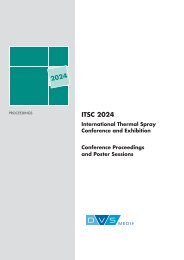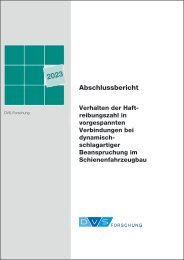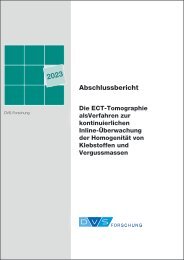STEEL + TECHNOLOGY 04/2019 EXTRACT
STEEL + TECHNOLOGY 04/2019 EXTRACT
STEEL + TECHNOLOGY 04/2019 EXTRACT
You also want an ePaper? Increase the reach of your titles
YUMPU automatically turns print PDFs into web optimized ePapers that Google loves.
52 | <strong>STEEL</strong> <strong>TECHNOLOGY</strong><br />
Traditional hot rolling will reheat billets<br />
from room temperature, consuming<br />
around 1.2 GJ/t heat by means of fossil<br />
fuels. Up to 1% product is lost as scale,<br />
and production is not continuous. With<br />
endless casting and rolling – including<br />
MI.DA. for long products and QSP-DUE<br />
for flat products – reheating furnace is<br />
eliminated along with its energy consumption<br />
and related emissions. Furthermore,<br />
there is no scale formation during reheating<br />
and no head/tail crops, reducing waste<br />
and increasing overall plant efficiency.<br />
Zero waste concepts<br />
Water. Industry must be committed to<br />
avoid wasting fresh water and so Danieli<br />
has set up a process (zero-water discharge<br />
– ZLD) wherein water treatment systems<br />
are able to recover blow-down water, with<br />
proper crystallization processes, to avoid<br />
any water discharge that may incur limits<br />
on salt content.<br />
Ecogravel. Slag is a secondary raw material<br />
that provides steel scrap, 4% by<br />
weight, and is an ideal aggregate (screened<br />
for differently sized particles) to be used in<br />
road paving or concrete applications. The<br />
Danieli Ecogravel process is three times<br />
beneficial for the environment:<br />
• It avoids the use of natural rocks, and<br />
the energy for crushing and transportation.<br />
• It reduces landfill disposal.<br />
• The high wearing resistance of the<br />
obtained asphalt makes roads more<br />
durable, reducing the frequency of<br />
repaving.<br />
Figure 4. Q-ONE system – the new Danieli patented technology handles irregular power<br />
loads with flexibility and reliability (Picture: Danieli)<br />
areas inside the meltshop, according to<br />
customers and environmental agencies<br />
request.<br />
Dioxins emissions reduction is also possible<br />
with the use of dedicated equipment,<br />
like the quenching tower or special dioxins<br />
abatement systems (when lower limits are<br />
required). For the control of other pollutants,<br />
like CO, NO x and SO x , it’s preferable<br />
to act directly “at the source”, by properly<br />
running the EAF and by choosing good<br />
quality raw materials.<br />
Noise reduction can be obtained by acting<br />
directly at the main source (EAF) with the<br />
installation of a dog house or with the<br />
sound-proofing of part of the building (elephant<br />
house). To reduce the noise dispersion<br />
in the surrounding areas it is necessary<br />
to control the emissions from the<br />
stacks. The new Acou-Stack solution may<br />
replace the traditional silencer installations.<br />
Scrap selection. Optimizing scrap selection<br />
reduces waste material because separating<br />
inert components (mainly glass)<br />
reduces lime additions, decreasing the<br />
volume of slag. Separating organic materials,<br />
like plastic and rubber, cuts gaseous<br />
emissions and limits the need for adsorbents<br />
to capture dioxins, thus containing<br />
the amount of dust generated. Also, scrap<br />
selection optimizes EAF operations so<br />
that melting models can manage<br />
power-on time.<br />
OpEx and ecological advantages<br />
with endless casting and rolling<br />
ASR (automotive shredder residue) has<br />
potential as a secondary raw material. It<br />
contains 5% inert materials, 10-15% of ferrous<br />
and nonferrous materials (which are<br />
easy to separate), and two organic fractions,<br />
equal by weight, having a calorific<br />
value up to 35MJ/kg. All evidence indicates<br />
the material may be used as a partial carbon<br />
substitute (up to 30%) for melting steel.<br />
Rolling<br />
Induction heaters are a sustainable alternative<br />
to gas-fueled reheating: no GHG,<br />
NO x or particulate emissions, limited scale<br />
formation, short start-up/shut-down, and<br />
high electrical efficiency are some of the<br />
benefits. Another advantage of the QHEAT<br />
Induction Heating System is the modularity<br />
that allows easy maintenance, optimal<br />
control and material temperature equalization,<br />
resulting in increased product quality.<br />
Low NO x burners. New-generation furnaces<br />
must respond to increasingly stringent<br />
emission limits. Design of high-efficiency<br />
burners requires<br />
thermo-flow-dynamics simulations with<br />
relevant combustion kinetics and final test-<br />
<strong>STEEL</strong> + <strong>TECHNOLOGY</strong> 1 (<strong>2019</strong>) No. 4


















